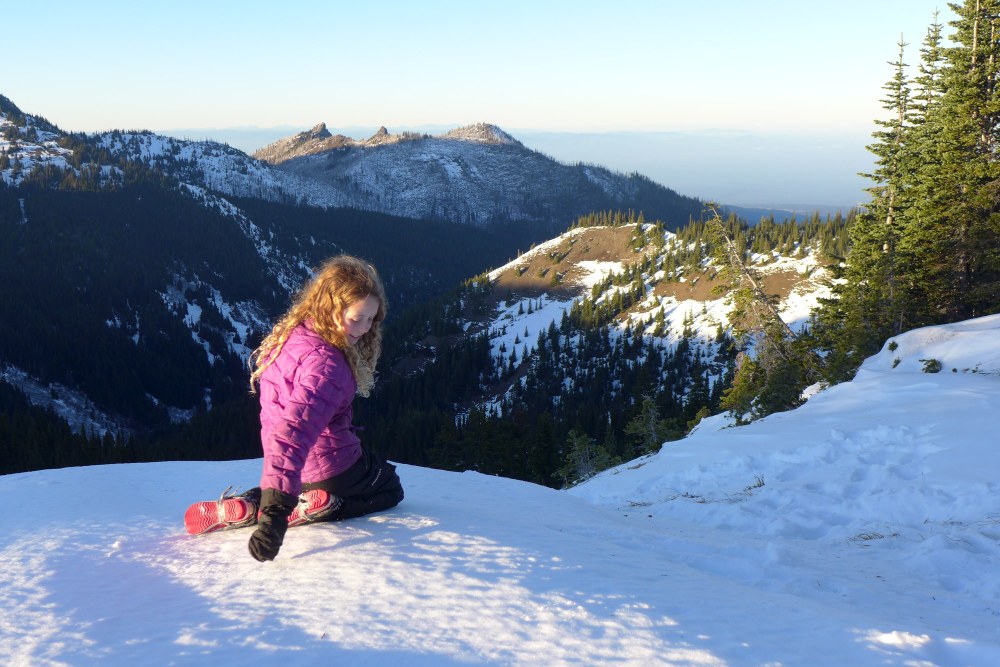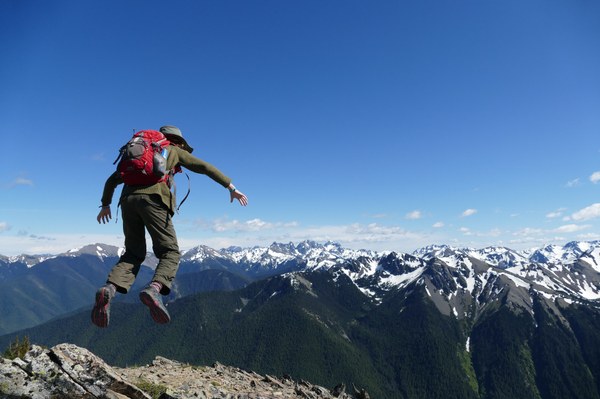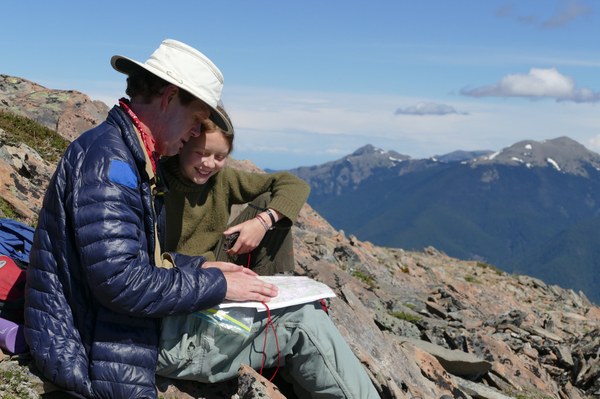
Our family has hiked together since our 12-year-old daughter was a newborn. I remember our daughter’s first decade as a series of literal peaks and valleys, many of them in the Olympics. I can picture her chasing butterflies over Marmot Pass at age five, and searching for fairies in old growth cathedrals along the Dungeness River. When she finished first grade we backpacked into Grand Valley, then clambered up Grand Peak, a perch with majestic views into the heart of the Olympic wilderness.
Gazing out toward the snow-streaked Cameron Basin, I remember having my first real conversation about climate change with our young daughter. She pulled out her compass, and her Dad unfolded a topo map, thinking this would be a good place to practice orienteering. She lifted the compass to her eyeline, and laid it on the map, considering the nearest ridge to the Southwest. Looking from map, to compass, then back to map again, she seemed befuddled. “Is there supposed to be a glacier there?” she asked.
She was right. The Lillian Glacier is gone, now a dark slope of scree and rubble. That year she framed climate change for her age group. If the North Pole is ice, she reasoned, and driving cars creates gas that melts ice, then eventually our vehicles will send Santa’s home into the sea. “If kids understood that,” she insisted, “they would never get in a car to go to school”. That year she began to bike to school, and she still does so to this day. When an older student launched a carbon footprint challenge as a graduating project, our family agreed to track our energy use for a month.
Doing this experiment revealed a very uncomfortable fact. Our most consumptive fossil fuel habit was also our greatest joy: heading to the mountains. We were proud of the many miles we’d hiked, snowshoed, and backpacked as a family, but we’d never stopped to consider all the miles we’d logged to trailheads, weekend after weekend. Even in a family of bike commuters, the bulk of our fossil fuel use was in transportation – as it is for many Northwest households.
Putting these numbers on paper created a conundrum for our family. Could we separate our hiking footprints from our carbon footprint? Spending time in the mountains gave us ample opportunity to see the impact of a changing climate on places we love. In just a decade, we’d witnessed unprecedented fires, disappearing glaciers, and variable snow pack. In recent years, we’ve hiked less in August due to smoke. Yet linking personal habits to large scale events is never easy. Most of us live in a world of compromise, even when we see changes in places we love.
Kicking carbon out of our hiking habit
Our family didn’t know how to kick the fossil fuel habit. The contradiction between our energy use and our love of wild places confounded us. Could we keep exploring the mountains without contributing to climate change? We decided to start with one goal: kicking the carbon out of our hiking habit.
I believe the urge to explore is deeply human. For centuries, people followed this impulse without fossil fuel: with wind, paddles, or on their own feet. However in contemporary American culture, the impulse to explore is entwined with the open road. Our love affair with road trips runs so deep that it has spawned an entire film genre and countless magazine covers. Meanwhile, the National Park Service has identified ground transportation by visitors as its biggest source of greenhouse gas emissions. Our family played a role in that statistic.
How many trailheads are accessible by public transportation? Too few, and I’d love to see more. One way to meet our goal was to consider an electric vehicle. At that point, all I knew about Electric Vehicles (EVs) could be summed up quickly: They don’t take gas; they do take money. As an environmental filmmaker and writer, I had plenty of motivation to reduce our gas habit, but limited resources to make it happen. Was there an EV that could get to a trailhead within range of our home and our budget?
We began to investigate. The first surprise was how affordable it is to lease an electric car – if it’s a Nissan Leaf. We test drove a model with an estimated range of over 100 miles. But we wondered: What does “estimated range” really mean when driving an EV in the mountains? These cars were designed with urban commuters in mind, not outdoor enthusiasts. Our test drive was fabulous in many ways: smooth, speedy, and silent, but we made a worrisome note when we went careening up a steep hill behind the dealership. The “anticipated mileage” plunged with each curve uphill. Topography mattered.
Nonetheless, the appeal of leasing an EV began to grow on all of us. The convenience of charging at home was seductive, a seldom mentioned benefit for rural drivers. The inner workings were strangely simple – no combustion, no oil. The car is so quiet, we’ve learned to knock on drive-through windows.
 Jumping for joy in the Olympics.
Jumping for joy in the Olympics.
Embracing a new normal
Two years and almost 20,000 miles after taking the plunge, we’ve learned how to drive a 30-kilowatt-battery car into the mountains and on road trips. We’ve been up Mt. St. Helens, across the Cascades, and to Bend, OR. We’ve made a long list of trailheads we can reach in the Olympics. It takes planning, but it doesn’t take gas. We began to see that without fuel costs, oil changes, or maintenance, switching to an EV made financial sense for our family as well.
In a few years, this “early adopter” story will be irrelevant. As we’ve adapted our habits to our new car, EV technology has continued to improve. Nonetheless, we rarely encounter other EVs at trailheads, and for that reason we offer a few practical tips for fellow hikers who want to follow in our footsteps.
It took a while to build confidence in our range, the barrier for many potential EV drivers. Topography, weather, and how you drive all matter. It’s a bit more like riding a horse than fueling a car – you learn be attentive to the needs of your ride. We’ve explored the unwritten rules of range over two years.
Practical tips for EV ownership
Rule #1: If you can climb up, you can get down. Going uphill uses battery power faster, roughly 1.5 kilowatt hours per thousand feet of elevation gain. The flip side: the battery recharges downhill – very satisfying! We’ve learned to keep an eye on varied topography in the backcountry, such as steep hills on a return trip. We’ve always used topo maps on the trail; now we check them when backcountry driving as well.
Rule #2: When possible use the “eco mode,” which extends range by tamping down the car’s acceleration potential. That is, unless you’re being trailed by a Hummer or a big truck - then turn off eco mode, and floor it for fun - nothing has the pickup of an EV! In general, slower driving means higher efficiency. Our EV gets better mileage on country roads at 40–50 mph than on high speed highways.
Rule #3: Consider the weather. The Leaf is well suited for moderate Northwest weather. On a typical 50 degree day, our Leaf clocks over 120 miles per charge, well above the list range. Range is reduced when the temperature is below freezing and during summer heatwaves; equally important, climate control uses battery power. Newer EVs are addressing temperature variation through improved technology, but we plan for it.
Rule #4: Understand charging options, and for now, plan ahead for longer trips. This is the most important lesson we learned. The infrastructure to support EVs is developing, and our region is ahead of most thanks to an agreement between Washington, Oregon, California, and British Columbia to develop the West Coast Electric Highway. Outside of the Tesla universe, which offers widespread charging for Tesla owners, EV drivers have three levels of charging options and all types of chargers are easy to find with an app called PlugShare.
Charging, rather than fueling, has transformed our experience of road trips. Public-private partnerships have established the West Coast Electric Highway, an extensive network of rapid charging stations along major roadway in British Columbia, Washington, Oregon, and California. The charging units have little in common with gas stations. We often find Level 3 chargers, which can charge our Leaf in under thirty minutes, tucked next to public buildings in town centers or close to local eateries and other attractions. We’ve gotten to know small towns we might have passed by otherwise.
Adopting solar power and other renewable sources – that can in turn power the electrification of the transportation system – is the most immediate step the greater Seattle region can take to reduce its carbon footprint. The new solar array at The Mountaineers program center is part of that puzzle. While much of the electricity used in Puget Sound is already carbon free, the bulk of that power is sourced from hydroelectricity. I’ve spent enough time filmmaking on the Elwha River to understand the steep tradeoffs inherent in hydropower; as a result our family’s next goal is to solar power our ride.
Adventure transformed
We’ve come a long way since our daughter pricked the family conscience, forcing us to examine habits that were part of our fiber. We love spending time in the mountains, but we can’t imagine going back to a combustion engine, even if it means making hard choices while infrastructure improves. In areas where rapid chargers aren’t available, we’ve learned to explore a little closer to home, and to consider trailheads we once passed over in our headlong rush to a ridge. We still leave a carbon footprint, of course, whether it’s getting on a plane to see family, or packing a stove into alpine areas. But we’ve made progress on our goal.
We began this family experiment to see if we could cut carbon use from outdoor recreation. Over two years, we learned something more profound: we’re building a different relationship with energy, one rooted in awareness. We worried about clipping our wings with the range limits of an EV. Instead, we discovered a newfound sense of freedom as we began to explore without gas. As we learned more about charging options, we realized that some chargers are shared by private homes, or businesses generating their own solar power. Not only were we leaving the fossil fuel industry behind – we were learning to access a renewable energy network that is more independent, for now, from major corporate providers. Tapping into this network began to change our narrative around road trips. What is freedom on the open road? Perhaps it’s freedom from fossil fuel, and all of the infrastructure that supports it.
I’m writing these final paragraphs from a campsite in the Icicle Valley. Getting to the Enchantments by Leaf is easier than hiking over Asgaard Pass, and yet we haven’t spotted another EV at Icicle Valley trailheads. We hope you’ll join us!
EV Trip Ideas
Many recreation areas in Washington are well served by EV infrastructure. Our family has enjoyed trips to:
The Cascades via Route Two: Getting over Stevens Pass by EV is easy, thanks to an extension of the West Coast Electric Highway on Route 2. In Sultan, the L3 charging station is across the street from the public library (which means our stop on Route 2 now involves the children’s book section, not a Shell station). Skykomish, Leavenworth, and Wenatchee all have convenient L3 rapid chargers, putting many Cascade destinations within reach, and Sleeping Lady Resort offers multiple L2 chargers at the gateway to the Enchantments.
Olympic National Park: Port Angeles now has two L3 chargers, including a free charger (plus free coffee!) at Wilder Nissan and a charger near the ferry terminal. L3 stations are scarce off of main highways, but L2 stations are widely available. On the Olympic Peninsula, the largest solar array in Jefferson County is at Finnriver Farm and Cidery in Chimacum, a delicious stop equipped with two EV chargers. Sol Duc Hotsprings and Resort also has a L2 charger, so you can soak while your EV charges.
Opportunities to improve infrastructure: Route 20 does not offer rapid charging, although L2 charging is available at the Mazama Country Inn. Adding L3 chargers in gateway communities that serve recreation areas, such as Concrete or Newhalem on Route 20, Forks on the West Olympic Peninsula, and Glacier en route to Mt. Baker, would greatly expand the wild places accessible by EV.
Charging Options & Mapping Locations
Planning a long distance EV trip is easy with apps that map charging locations, such as Plugshare. Most EVs are equipped with three levels of charging options.
Level 3: The key to long distance travel by EV is Level 3 (L3) charging, which offers rapid charging in the range of 20 minutes. Rapid charging stations come in several formats: Japanese cars such as the Leaf use CHAdeMO fast chargers, and American and European cars use CCS fast chargers. Tesla’s proprietary version serves Tesla vehicles only. For long trips, it’s wise to check ahead and set up an account with companies that operate L3 chargers on your route. Many stations are designed for both CHAdeMO and CCS. The West Coast Electric Highway provides L3 charging at regular intervals on major highways.
Level 2: A Nissan Leaf takes 3-4 hours to fully charge at a Level 2 (L2) station. These units are widely available in the Pacific Northwest and many (though not all) are free.
Level 1: This is the most basic charging method. Level 1 (L1) is essentially any regular electric outlet. Most EVs can charge overnight with a standard plug. A campground with an outlet, or an extension cord from a house, will do the job. The vast majority of driving can be accomplished with L1 or L 2 charging options, but L3 chargers make longer road trips possible. Charging stations at all levels can be found at plugshare.com, which offers a check-in system for users, a handy way to see if a charger is working and available.
If you’re considering an EV, it helps to find knowledgeable people with personal experience. We leased at Nissan in Bremerton, thanks in part to a salesperson who drove his own Leaf to ski. We also became members of our local EV club, and these growing clubs offer a wealth of information for new EV drivers.
 Still orienteering in the Olympics, now getting there by Leaf.
Still orienteering in the Olympics, now getting there by Leaf.
Jessica Plumb is an award-winning filmmaker and writer based on the Olympic Peninsula, best known for a feature documentary on the restoration of the Elwha River, Return of the River. Before making a home on the Olympic Peninsula in 2000, she worked in Boston and Beijing, and now lives happily in the shadow of the Olympics with her family and EV.
This article originally appeared in our Winter 2019 issue of Mountaineer Magazine. To view the original article in magazine form and read more stories from our publication, click here.
Add a comment
Log in to add comments.Jessica, thanks for this article. I bought a Volkswagen e-golf in June 2019 and thus far have used it only for commuting and city driving. We've still used my husband's Subie for hiking. This has inspired me to us my EV to get out on the trails. As soon as the current SIP lifts, I'm inspired to give it a try!
 Jessica Plumb
Jessica Plumb